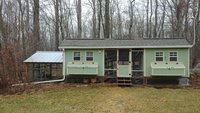Hickorychickens
Chirping
- Mar 29, 2015
- 14
- 20
- 67
Perhaps an end of the insulation debate?
I built two coops, nearly identical with the exception that one is insulated and the other is not. I live in Northeastern CT. Both coops are identical in size and build, they each measure 6x8 with an interior peak height of 6'. Both have 2x4 16oc wall and roof construction and 2x6 floor joist also 16oc. Both coops have R-19 insulation in the floors. The insulated coop has R-13 wall insulation with the interior of the walls covered with 1/2" OSB plywood, the ceiling has reflective radiant heat barrier attached to the underside of the rafters. The uninsulated coop only has the R-19 insulation in the floors, no wall insulation, no interior wall, no radiant heat barrier on the ceiling. In the attached picture the insulated coop is on the left.
The insulated coop was built in 2015 while the uninsulated coop was built in 2017. I designed and built both coops. The insulated coop houses 10 chickens (3 buff orphingtons, 3 barred rocks, 3 new Hampshire reds, 1 black sex linked) while the uninsulated coop houses 12 chickens (4 speckled Sussex, 3 silver wyandottes, 3 black austrolops, 1 copper maran, 1 olive egger). Coops have the same windows, same automatic door, same ventilation, same roofing material, same number of nesting boxes, etc..
What I have found is that during the summer months the uninsulated coop runs about 2 degrees warmer than the insulated coop during the day but the uninsulated coops cools down much quicker at night and runs about 2-3 degrees cooler than the insulated coop as soon as an hour after sunset. During the winter the insulated coop is warmer during the day and night. The uninsulated coop is at ambient temperature during the day and generally 2-4 degrees above ambient temperature at night. While the insulated coop runs 4-6 degrees above ambient temperature during the day and generally 6-8 degrees above ambient temperature at night. I do not heat my coops at night. I have made sure that both coops are as draft-free as possible. Both coops have electricity and have heated waterers inside.
I monitor the temperatures in my coop with the Ambient Weather WS-3000-X3 Thermo-Hygrometer Wireless Monitor with 3 Remote Sensors. My coops are about 100ft from my house.
We had a brutal 2 weeks in late December through early January with nighttime low temperatures for several nights in a row of minus 2 to minus 8 degrees. The uninsulated coop got as low as minus 2 degrees on the coldest night while on the same night the insulated coop had a low temperature of +6 degrees. Regardless, all my chickens did fine with no evidence of frostbite.
I will let each reader of my experience draw their own conclusions on whether they choose to insulate or not. If I can help clarify any information, please ask.
I built two coops, nearly identical with the exception that one is insulated and the other is not. I live in Northeastern CT. Both coops are identical in size and build, they each measure 6x8 with an interior peak height of 6'. Both have 2x4 16oc wall and roof construction and 2x6 floor joist also 16oc. Both coops have R-19 insulation in the floors. The insulated coop has R-13 wall insulation with the interior of the walls covered with 1/2" OSB plywood, the ceiling has reflective radiant heat barrier attached to the underside of the rafters. The uninsulated coop only has the R-19 insulation in the floors, no wall insulation, no interior wall, no radiant heat barrier on the ceiling. In the attached picture the insulated coop is on the left.
The insulated coop was built in 2015 while the uninsulated coop was built in 2017. I designed and built both coops. The insulated coop houses 10 chickens (3 buff orphingtons, 3 barred rocks, 3 new Hampshire reds, 1 black sex linked) while the uninsulated coop houses 12 chickens (4 speckled Sussex, 3 silver wyandottes, 3 black austrolops, 1 copper maran, 1 olive egger). Coops have the same windows, same automatic door, same ventilation, same roofing material, same number of nesting boxes, etc..
What I have found is that during the summer months the uninsulated coop runs about 2 degrees warmer than the insulated coop during the day but the uninsulated coops cools down much quicker at night and runs about 2-3 degrees cooler than the insulated coop as soon as an hour after sunset. During the winter the insulated coop is warmer during the day and night. The uninsulated coop is at ambient temperature during the day and generally 2-4 degrees above ambient temperature at night. While the insulated coop runs 4-6 degrees above ambient temperature during the day and generally 6-8 degrees above ambient temperature at night. I do not heat my coops at night. I have made sure that both coops are as draft-free as possible. Both coops have electricity and have heated waterers inside.
I monitor the temperatures in my coop with the Ambient Weather WS-3000-X3 Thermo-Hygrometer Wireless Monitor with 3 Remote Sensors. My coops are about 100ft from my house.
We had a brutal 2 weeks in late December through early January with nighttime low temperatures for several nights in a row of minus 2 to minus 8 degrees. The uninsulated coop got as low as minus 2 degrees on the coldest night while on the same night the insulated coop had a low temperature of +6 degrees. Regardless, all my chickens did fine with no evidence of frostbite.
I will let each reader of my experience draw their own conclusions on whether they choose to insulate or not. If I can help clarify any information, please ask.




